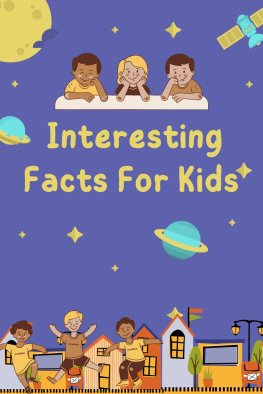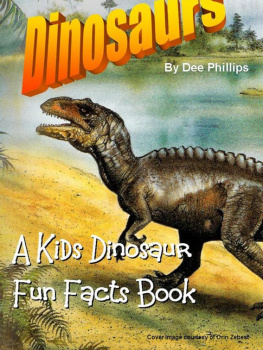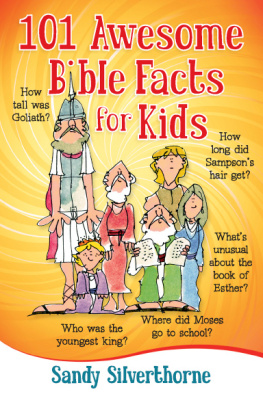





This book is a collection of fun science facts.
Their purpose is to make children think and stretch their minds.
The book is arranged in Seven rounds.
TABLE OF CONTENTs








 The word dinosaur comes from the Greek language and means terrible lizard. The word was coined by English paleontologist Richard Owen in 1842 and was meant to refer to Dinosaurs impressive size rather than their scary appearance.
The word dinosaur comes from the Greek language and means terrible lizard. The word was coined by English paleontologist Richard Owen in 1842 and was meant to refer to Dinosaurs impressive size rather than their scary appearance.
 Dinosaurs ruled the Earth for over million years, from the Triassic period around 230 million years ago through the Jurassic period and until the end of the Cretaceous period around million years ago.
Dinosaurs ruled the Earth for over million years, from the Triassic period around 230 million years ago through the Jurassic period and until the end of the Cretaceous period around million years ago.
 The time period from million years ago until around million years ago is known as the Mesozoic Era. It is often referred to as the Age of the Dinosaurs because most dinosaurs developed and became extinct during this time.
The time period from million years ago until around million years ago is known as the Mesozoic Era. It is often referred to as the Age of the Dinosaurs because most dinosaurs developed and became extinct during this time.
 It is believed that dinosaurs lived on Earth until around million years ago when a mass extinction occurred.
It is believed that dinosaurs lived on Earth until around million years ago when a mass extinction occurred.
 Scientists believe that the event leading to the extinction may have been a massive asteroid impact or huge volcanic activity. Events such as these could have blocked out sunlight and significantly changed the Earths ecology.
Scientists believe that the event leading to the extinction may have been a massive asteroid impact or huge volcanic activity. Events such as these could have blocked out sunlight and significantly changed the Earths ecology.
 The first dinosaur to be formally named was the Megalosaurus, back in 1824.
The first dinosaur to be formally named was the Megalosaurus, back in 1824.
 A person who studies dinosaurs is known as a paleontologist.
A person who studies dinosaurs is known as a paleontologist.
 Rather than being carnivores (meat eaters), the largest dinosaurs such as the Brachiosaurus and Apatosaurus were actually herbivores (plant eaters).
Rather than being carnivores (meat eaters), the largest dinosaurs such as the Brachiosaurus and Apatosaurus were actually herbivores (plant eaters).
 To help fight meat eaters such as the Allosaurus or Spinosaurus, many plant eaters had natural weapons at their disposal. Examples of this include the spikes on the tail of the Stegosaurus and the three horns attached to the front of the Triceratopss head shield.
To help fight meat eaters such as the Allosaurus or Spinosaurus, many plant eaters had natural weapons at their disposal. Examples of this include the spikes on the tail of the Stegosaurus and the three horns attached to the front of the Triceratopss head shield.
 Pterodactyls are not dinosaurs, they were flying reptiles that lived during the age of dinosaurs but by definition they do not fall into the same category. The same goes for water based reptiles such as Plesiosaurs.
Pterodactyls are not dinosaurs, they were flying reptiles that lived during the age of dinosaurs but by definition they do not fall into the same category. The same goes for water based reptiles such as Plesiosaurs.
 Birds descended from a type of dinosaurs known as theropods.
Birds descended from a type of dinosaurs known as theropods.
 Despite being long extinct, dinosaurs are frequently featured in the media. One of the more memorable examples of this is Michael Crichtons 1990 book Jurassic Park. Adapted to movie in 1993, the story features cloned dinosaurs brought to life with the help of DNA found in mosquitoes trapped in amber.
Despite being long extinct, dinosaurs are frequently featured in the media. One of the more memorable examples of this is Michael Crichtons 1990 book Jurassic Park. Adapted to movie in 1993, the story features cloned dinosaurs brought to life with the help of DNA found in mosquitoes trapped in amber.
 Dinosaur fossils have been found on every continent of Earth, including Antarctica.
Dinosaur fossils have been found on every continent of Earth, including Antarctica.
 Fossils help us understand what the dinosaurs were like.
Fossils help us understand what the dinosaurs were like.
Information can be gathered from sources such as fossilized bones, footprints, stomach stones, feces, internal organs, soft tissues, eggs and feathers.
 Over 1000 different species of dinosaurs have been named and the list continues to grow as new fossils are discovered.
Over 1000 different species of dinosaurs have been named and the list continues to grow as new fossils are discovered.
 Some of the largest fossilized dinosaur eggs ever discovered were found in China in the mid 1990s. The eggs are over 60cm (2ft) long and 20cm (8in) wide.
Some of the largest fossilized dinosaur eggs ever discovered were found in China in the mid 1990s. The eggs are over 60cm (2ft) long and 20cm (8in) wide.
 The tail of the Diplodocus is believed to have been made up of around vertebrae.
The tail of the Diplodocus is believed to have been made up of around vertebrae.
 The most common form of Stegosaurus featured four tail spikes which were used to combat carnivores (meat eaters) such as the Allosaurus.
The most common form of Stegosaurus featured four tail spikes which were used to combat carnivores (meat eaters) such as the Allosaurus.
 Dinosaur fossils have been known for a long time in human history but it wasnt until the early 19th century that they were formally recognized as the dinosaurs we learn about today.
Dinosaur fossils have been known for a long time in human history but it wasnt until the early 19th century that they were formally recognized as the dinosaurs we learn about today.
 When English paleontologist Richard Owen coined the
When English paleontologist Richard Owen coined the
term dinosaur in 1842 he based the name on the remains that had been discovered at that time, which included
the Megalosaurus, Iguanodon and Hylaeosaurus. These remains shared distinctive features which led Owen to label them as a distinct group, different from other species known at the time.
 In 1858, one of the first almost complete dinosaur skeletons was discovered in New Jersey. What made this discovery special was that it was a bipedal dinosaur, meaning one that moved on two legs. Most scientists had previously thought that all dinosaurs moved on four feet.
In 1858, one of the first almost complete dinosaur skeletons was discovered in New Jersey. What made this discovery special was that it was a bipedal dinosaur, meaning one that moved on two legs. Most scientists had previously thought that all dinosaurs moved on four feet.
Next page





























 The word dinosaur comes from the Greek language and means terrible lizard. The word was coined by English paleontologist Richard Owen in 1842 and was meant to refer to Dinosaurs impressive size rather than their scary appearance.
The word dinosaur comes from the Greek language and means terrible lizard. The word was coined by English paleontologist Richard Owen in 1842 and was meant to refer to Dinosaurs impressive size rather than their scary appearance.